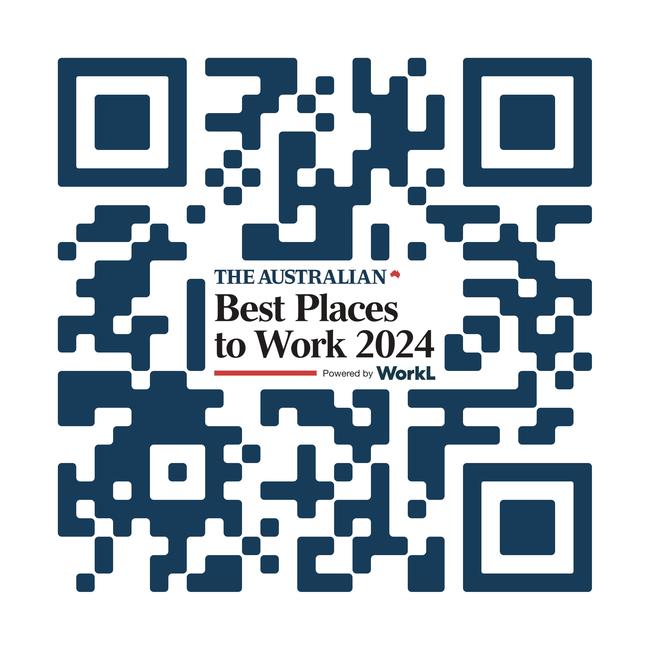Happier staff bring greater profits
Employee happiness is directly correlated to engagement levels, which lead to greater profit. Is your workplace happy? Enter The Australian Best Places to Work awards and find out.

Businesses seeking to increase their profit invariably keep their employees happy.
This is because employee happiness is directly correlated to engagement levels and productivity, which leads to greater profit.
It’s a simple formula that successful employers consistently follow, says Lord Mark Price, the founder of employee engagement platform WorkL.
“Organisations with the highest levels of staff happiness see greater productivity, customer satisfaction and profits,” says Price, who champions a methodology that measures and helps companies track the engagement levels of their employees.
In partnership with WorkL and using its powerful methodology, The Australian has embarked on a quest to find the happiest workplaces in the nation, with many awards to be won by businesses taking part.
The WorkL methodology measures employee happiness and engagement across six categories: reward and recognition; information sharing; empowerment; wellbeing; job satisfaction; and instilling pride.
The benefits for organisations using this methodology include many measures they can act on and use in order to become more competitive, productive and profitable while shoring up the happiness levels of employees.
“Working with hundreds of organisations we can measure employees’ happiness and also staff turnover, sick absence and productivity,” Price says.
“What we see universally is that those organisations with happier and more engaged employees get more from their people and gain a competitive advantage. While some might think giving staff free pizza or a pool table in the rest area might do the trick, the answer to staff happiness is more straightforward.
“Being paid fairly, being recognised when you do something well, being given information to do your job effectively, being listened to and being shown respect, feeling that your boss cares about how you are doing, feeling proud of what you do and being developed are all important elements.
“Sadly more than 80 per cent of managers have no management training and many are promoted because they have either been around a long time or because they have a technical qualification. There are too many ‘accidental managers’ and this can impact on how a team is led and encouraged.”
Extra discretionary effort
In Price’s view, measuring employee engagement and happiness is the first step on the path to greater profitability.
“Employee engagement can be measured through the six-step framework,” he says.
“It’s important to measure because it drives commercial performance. Great customer service starts with the employee feeling positive and happy.”
Organisations that do not track employee engagement levels are at risk of flight risk, an important measure that organisations can use. Flight risk is the percentage of people who have a high potential to leave their organisation.
It is important to measure employee engagement because it is a key driver of commercial success for the organisation.
“Great customer service starts with the employee feeling positive and happy,” Price says.

Disengaged employees leave their organisations, with employers incurring huge expenses in finding competent talent to replace the skills they have lost.
“Disengaged employees leave their manager, they take more sick leave, they do the minimum required to do their job. This affects the bottom line,” Price says.
“The main reason people leave organisations is the poor relationship they have with their boss; because their manager has not created a positive environment in which they want to work. But even worse for an organisation is unhappy employees who stay in spite of that poor relationship and simply go through the motions.”

Staff who are happier and fully engaged in what they do at work bring an extra something into the work. This extra ingredient is the secret sauce of greater profitability. This bonus contribution from employees is referred to as extra discretionary effort.
“The best workplaces are able to get extra discretionary effort from their employees because of the way they are managed and the working culture that is created,” Price says.
“The best sports coaches manage to get more from their players. They turn average to good and good to brilliant. They get their team to give extra discretionary effort. The same is true in business. The best managers and leaders encourage more from their employees. It is this that leads them to outperform their competitors.
“Countless academic studies have shown that businesses with the happiest and most engaged employees outperform their competitors. They have lower levels of staff turnover and sick absence and on average 20 per cent higher profits. A recent American study showed earnings per share were 134 per cent higher where workforces were highly engaged.
“It’s for this reason I built WorkL – to measure, track and improve employee effort. We are very good in business at measuring sales, production or costs but just, if not more important, is measuring the impact management (has) on driving higher levels of effort and performance from employees.”
Measure happiness first
What should employers do and what should employees do in order to achieve the best outcome at the workplace?
“First measure how employees really feel,” Price says.
“Where are the managers doing a great job and where are the managers with the scope to improve. From that you can build a plan for development.
“I feel employees have just as much responsibility for their happiness at work as their manager. They could start by taking the WorkL ‘Happy at Work’ test which is free of charge and will show them just how happy they are compared to the millions of others who have completed it.”
Organisations that wish to outperform their peers in their sector start with quantified, actionable data on employee happiness and flight risk.
“The quickest win for an organisation is to improve retention. If you can keep the people you have trained, you significantly reduce hiring and training costs and your customers get better consistent service,” Price says.
“We measure flight risk, which shows organisations what percentage of their organisation will leave in the next six to nine months by demographic and section.”
Getting the best out of staff is an ongoing process and managers play a key role in the retention and engagement levels of staff. Many teams perform well because of conscious effort to improve staff engagement.
They outperform the market because “their managers understand what their team needs to deliver”, says Price. “There’s a clear well communicated plan, managers give people the training and resources to deliver, they coach when things are going off track and praise when things are going well and they genuinely care for their team.”
WorkL methodology
Organisations wishing to see themselves in The Australian’s Best Places to Work 2024 list have a double benefit while take the WorkL survey and entering the awards. They get to see where they are doing well (or failing) in their efforts to retain their staff – in the process, they also get a dashboard of data that they can use in order to get the best out of their staff. They also get the kudos attached to being in the company of the best in their sector. There are also many awards to be won.
“WorkL helps organisations and individuals to measure, track and improve employee engagement across the employee lifecycle, in turn improving productivity and profitability,” Price says.
“WorkL’s proprietary Instant Action Software ™ delivers immediate, tailored action points and resources to drive productivity straightaway.
“WorkL’s methodology has been created to deliver increased employee discretionary effort, which increases commercial performance.
“We help organisations monitor, track and improve employee engagement with market-leading surveys, providing immediate predictive data analytics through intuitive dashboards for both management and employees.
“WorkL’s Instant Action Software™ instantly analyses large complex data sets to pinpoint development areas. We then provide action plans with uniquely tailored resources for managers at all levels as well as team members, if required, to improve performance.”
As the war for talent intensifies, it makes sense for organisations to discover if staff are engaged enough to stay on or are unhappy.
Staff leaving the organisation is a huge cost imposition that employers will do well to avoid, especially when many things are going right for the business and conditions are just right to attract talent rather than turning employees away. Reducing sick leave is another way in which similar savings can be achieved.
So it makes sense to measure the happiness level of staff, which instantly translates to phenomenal improvement to the bottom line. Add to that the extra discretionary effort from happier staff, which results in more productivity, better products and better service, and the end result is a vastly improved competitive advantage for organisations.
Best Places to Work
Management skills are measurable, and it pays to measure them, Price says. Taking the WorkL survey is the first step to becoming a better managed, more productive and happier workplace, he adds.
“The best organisations get the most from their people,” he says.
“They achieve higher levels of extra discretionary effort. They achieve this through great leadership and management. They track their progress on this as diligently as their sales and cost lines.”
Effective managers follow the data on staff engagement levels.
“Getting more from your existing people – and retaining the skill you have – become even more important in a tight labour market,” Price says.
“That’s why the data companies get from entering these awards is so helpful.”
Entering the awards for The Australian Best Places to Work 2024 is the pathway to being recognised as an employer of choice.
Price says the awards build pride for employees and help with retention of talent. Entering the list of the best places to work can also be a magnet for attracting potential staff by boosting visibility for management performance, as the best places to work will be celebrated in The Australian’s print and online pages.
“The cost of entering the awards and completing the survey is a fraction of the benefit a company will get from understanding where poor management is holding back performance and great management practice can be celebrated and shared.
“Organisations will see where there are issues with wellbeing risk or flight risk and can intervene to reduce sick absence and people leaving for a competitor.
“And by understanding scores against the six steps, they can boost worker happiness to drive productivity.”
The dashboard of data that an organisation gets from entering the awards becomes a compass that guides the management to help staff achieve market-beating engagement levels.
“WorkL has collected employee sentiment data from over 60,000 organisations,” Price says.
“Companies using the WorkL survey, therefore, not only receive internal insights on how an organisation’s employees feel but can compare their score against competitors, industry and by geography.
“Predictive analytics let organisations see the number of employees who are highly likely to leave in the near future and those that are a wellbeing risk. There’s an index to show how inclusive the company is and another that shows how well management is doing. But most importantly, results can be filtered by a range of demographics to pinpoint where there are areas for improvement as well as celebration.
“With the WorkL data you can slice and dice by age, gender, ethnicity, disability and much more.
“You can also measure a manager’s impact on whether they are getting the most from their team. When it’s done well, it leads to a better working experience for employees, higher profits for companies, higher revenues for the government and a better society.”
-
The last date to enter The Australian Best Places to Work and submit your survey is May 31. Don’t miss out!
Visit business.workl.co/workplace-awards/the-australian-au to enter. To find out more, contact theaustralianbestplacestowork@workl.com.au
-




